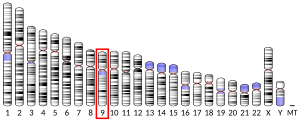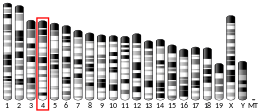
Summary
Paired box protein Pax-5 is a protein that in humans is encoded by the PAX5 gene.[5][6][7]
| PAX5 | |||||||||||||||||||||||||||||||||||||||||||||||||||
|---|---|---|---|---|---|---|---|---|---|---|---|---|---|---|---|---|---|---|---|---|---|---|---|---|---|---|---|---|---|---|---|---|---|---|---|---|---|---|---|---|---|---|---|---|---|---|---|---|---|---|---|
 | |||||||||||||||||||||||||||||||||||||||||||||||||||
| |||||||||||||||||||||||||||||||||||||||||||||||||||
| Identifiers | |||||||||||||||||||||||||||||||||||||||||||||||||||
| Aliases | PAX5, ALL3, BSAP, paired box 5, PAX-5 | ||||||||||||||||||||||||||||||||||||||||||||||||||
| External IDs | OMIM: 167414 MGI: 97489 HomoloGene: 56419 GeneCards: PAX5 | ||||||||||||||||||||||||||||||||||||||||||||||||||
| |||||||||||||||||||||||||||||||||||||||||||||||||||
| |||||||||||||||||||||||||||||||||||||||||||||||||||
| |||||||||||||||||||||||||||||||||||||||||||||||||||
| |||||||||||||||||||||||||||||||||||||||||||||||||||
| |||||||||||||||||||||||||||||||||||||||||||||||||||
| Wikidata | |||||||||||||||||||||||||||||||||||||||||||||||||||
| |||||||||||||||||||||||||||||||||||||||||||||||||||
Function edit
The PAX5 gene is a member of the paired box (PAX) family of transcription factors. The central feature of this gene family is a novel, highly conserved DNA-binding domain, known as the paired box. The PAX proteins are important regulators in early development, and alterations in the expression of their genes are thought to contribute to neoplastic transformation. The PAX5 gene encodes the B-cell lineage specific activator protein (BSAP) that is expressed at early, but not late stages of B-cell differentiation. Its expression has also been detected in developing CNS and testis, therefore, PAX5 gene product may not only play an important role in B-cell differentiation, but also in neural development and spermatogenesis.[7]
Clinical significance edit
The PAX5 gene is located in chromosome 9p13 region, which is involved in t(9;14)(p13;q32) translocations recurring in small lymphocytic lymphomas of the plasmacytoid subtype, and in derived large-cell lymphomas. This translocation brings the potent E-mu enhancer of the IgH gene locus into close proximity of the PAX5 promoters, suggesting that the deregulation of PAX5 gene transcription contributes to the pathogenesis of these lymphomas.[7]
Up to 97% of the Reed–Sternberg cells of Hodgkin's lymphoma express Pax-5.[8]
Interactions edit
PAX5 has been shown to interact with TLE4[9][10] and Death associated protein 6.[11]
See also edit
References edit
- ^ a b c GRCh38: Ensembl release 89: ENSG00000196092 – Ensembl, May 2017
- ^ a b c GRCm38: Ensembl release 89: ENSMUSG00000014030 – Ensembl, May 2017
- ^ "Human PubMed Reference:". National Center for Biotechnology Information, U.S. National Library of Medicine.
- ^ "Mouse PubMed Reference:". National Center for Biotechnology Information, U.S. National Library of Medicine.
- ^ Adams B, Dörfler P, Aguzzi A, Kozmik Z, Urbánek P, Maurer-Fogy I, Busslinger M (Sep 1992). "Pax-5 encodes the transcription factor BSAP and is expressed in B lymphocytes, the developing CNS, and adult testis". Genes & Development. 6 (9): 1589–607. doi:10.1101/gad.6.9.1589. PMID 1516825.
- ^ Pilz AJ, Povey S, Gruss P, Abbott CM (March 1993). "Mapping of the human homologs of the murine paired-box-containing genes". Mammalian Genome. 4 (2): 78–82. doi:10.1007/BF00290430. PMID 8431641. S2CID 30845070.
- ^ a b c "Entrez Gene: PAX5 paired box gene 5 (B-cell lineage specific activator)".
- ^ Torlakovic E, Torlakovic G, Nguyen PL, Brunning RD, Delabie J (Oct 2002). "The value of anti-pax-5 immunostaining in routinely fixed and paraffin-embedded sections: a novel pan pre-B and B-cell marker". The American Journal of Surgical Pathology. 26 (10): 1343–50. doi:10.1097/00000478-200210000-00011. PMID 12360049. S2CID 7703197.
- ^ Eberhard D, Jiménez G, Heavey B, Busslinger M (May 2000). "Transcriptional repression by Pax5 (BSAP) through interaction with corepressors of the Groucho family". The EMBO Journal. 19 (10): 2292–303. doi:10.1093/emboj/19.10.2292. PMC 384353. PMID 10811620.
- ^ Milili M, Gauthier L, Veran J, Mattei MG, Schiff C (Aug 2002). "A new Groucho TLE4 protein may regulate the repressive activity of Pax5 in human B lymphocytes". Immunology. 106 (4): 447–55. doi:10.1046/j.1365-2567.2002.01456.x. PMC 1782747. PMID 12153506.
- ^ Emelyanov AV, Kovac CR, Sepulveda MA, Birshtein BK (Mar 2002). "The interaction of Pax5 (BSAP) with Daxx can result in transcriptional activation in B cells". The Journal of Biological Chemistry. 277 (13): 11156–64. doi:10.1074/jbc.M111763200. PMID 11799127.
Further reading edit
- Hagman J, Wheat W, Fitzsimmons D, Hodsdon W, Negri J, Dizon F (1999). "Pax-5/BSAP: Regulator of Specific Gene Expression and Differentiation in B Lymphocytes". Signal Transduction and the Coordination of B Lymphocyte Development and Function I. Current Topics in Microbiology and Immunology. Vol. 245. pp. 169–94. doi:10.1007/978-3-642-57066-7_5. ISBN 978-3-642-63017-0. PMID 10533313.
- Calame KL, Lin KI, Tunyaplin C (2003). "Regulatory mechanisms that determine the development and function of plasma cells". Annual Review of Immunology. 21: 205–30. doi:10.1146/annurev.immunol.21.120601.141138. PMID 12524387.
- Carotta S, Holmes ML, Pridans C, Nutt SL (Nov 2006). "Pax5 maintains cellular identity by repressing gene expression throughout B cell differentiation". Cell Cycle. 5 (21): 2452–6. doi:10.4161/cc.5.21.3396. PMID 17102626.
- Stapleton P, Weith A, Urbánek P, Kozmik Z, Busslinger M (Apr 1993). "Chromosomal localization of seven PAX genes and cloning of a novel family member, PAX-9". Nature Genetics. 3 (4): 292–8. doi:10.1038/ng0493-292. PMID 7981748. S2CID 21338655.
- Busslinger M, Klix N, Pfeffer P, Graninger PG, Kozmik Z (Jun 1996). "Deregulation of PAX-5 by translocation of the Emu enhancer of the IgH locus adjacent to two alternative PAX-5 promoters in a diffuse large-cell lymphoma". Proceedings of the National Academy of Sciences of the United States of America. 93 (12): 6129–34. Bibcode:1996PNAS...93.6129B. doi:10.1073/pnas.93.12.6129. PMC 39201. PMID 8650231.
- Iida S, Rao PH, Nallasivam P, Hibshoosh H, Butler M, Louie DC, Dyomin V, Ohno H, Chaganti RS, Dalla-Favera R (Dec 1996). "The t(9;14)(p13;q32) chromosomal translocation associated with lymphoplasmacytoid lymphoma involves the PAX-5 gene". Blood. 88 (11): 4110–7. doi:10.1182/blood.V88.11.4110.4110. PMID 8943844.
- Kaneko H, Ariyasu T, Inoue R, Fukao T, Kasahara K, Teramoto T, Matsui E, Hayakawa S, Kondo N (Feb 1998). "Expression of Pax5 gene in human haematopoietic cells and tissues: comparison with immunodeficient donors". Clinical and Experimental Immunology. 111 (2): 339–44. doi:10.1046/j.1365-2249.1998.00509.x. PMC 1904901. PMID 9486401.
- Verkoczy LK, Berinstein NL (Oct 1998). "Isolation of genes negatively or positively co-expressed with human recombination activating gene 1 (RAG1) by differential display PCR (DD RT-PCR)". Nucleic Acids Research. 26 (19): 4497–507. doi:10.1093/nar/26.19.4497. PMC 147860. PMID 9742255.
- Wheat W, Fitzsimmons D, Lennox H, Krautkramer SR, Gentile LN, McIntosh LP, Hagman J (Mar 1999). "The highly conserved beta-hairpin of the paired DNA-binding domain is required for assembly of Pax-Ets ternary complexes". Molecular and Cellular Biology. 19 (3): 2231–41. doi:10.1128/mcb.19.3.2231. PMC 84016. PMID 10022910.
- Eberhard D, Busslinger M (Apr 1999). "The partial homeodomain of the transcription factor Pax-5 (BSAP) is an interaction motif for the retinoblastoma and TATA-binding proteins". Cancer Research. 59 (7 Suppl): 1716s–1724s, discussion 1724s–1725s. PMID 10197586.
- Libermann TA, Pan Z, Akbarali Y, Hetherington CJ, Boltax J, Yergeau DA, Zhang DE (Aug 1999). "AML1 (CBFalpha2) cooperates with B cell-specific activating protein (BSAP/PAX5) in activation of the B cell-specific BLK gene promoter". The Journal of Biological Chemistry. 274 (35): 24671–6. doi:10.1074/jbc.274.35.24671. PMID 10455134.
- Nutt SL, Heavey B, Rolink AG, Busslinger M (Oct 1999). "Commitment to the B-lymphoid lineage depends on the transcription factor Pax5". Nature. 401 (6753): 556–62. Bibcode:1999Natur.401..556N. doi:10.1038/44076. PMID 10524622. S2CID 4414876.
- Rolink AG, Nutt SL, Melchers F, Busslinger M (Oct 1999). "Long-term in vivo reconstitution of T-cell development by Pax5-deficient B-cell progenitors". Nature. 401 (6753): 603–6. Bibcode:1999Natur.401..603R. doi:10.1038/44164. PMID 10524629. S2CID 12257992.
- Kovac CR, Emelyanov A, Singh M, Ashouian N, Birshtein BK (Jun 2000). "BSAP (Pax5)-importin alpha 1 (Rch1) interaction identifies a nuclear localization sequence". The Journal of Biological Chemistry. 275 (22): 16752–7. doi:10.1074/jbc.M001551200. PMID 10748034.
- Eberhard D, Jiménez G, Heavey B, Busslinger M (May 2000). "Transcriptional repression by Pax5 (BSAP) through interaction with corepressors of the Groucho family". The EMBO Journal. 19 (10): 2292–303. doi:10.1093/emboj/19.10.2292. PMC 384353. PMID 10811620.
- Roberts EC, Deed RW, Inoue T, Norton JD, Sharrocks AD (Jan 2001). "Id helix-loop-helix proteins antagonize pax transcription factor activity by inhibiting DNA binding". Molecular and Cellular Biology. 21 (2): 524–33. doi:10.1128/MCB.21.2.524-533.2001. PMC 86614. PMID 11134340.
- Pasqualucci L, Neumeister P, Goossens T, Nanjangud G, Chaganti RS, Küppers R, Dalla-Favera R (Jul 2001). "Hypermutation of multiple proto-oncogenes in B-cell diffuse large-cell lymphomas". Nature. 412 (6844): 341–6. Bibcode:2001Natur.412..341P. doi:10.1038/35085588. PMID 11460166. S2CID 4373198.
External links edit
- PAX5+protein,+human at the U.S. National Library of Medicine Medical Subject Headings (MeSH)
- FactorBook PAX5
- Overview of all the structural information available in the PDB for UniProt: Q02548 (Paired box protein Pax-5) at the PDBe-KB.
This article incorporates text from the United States National Library of Medicine, which is in the public domain.








